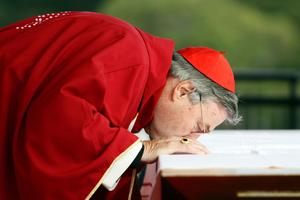Steady Stream of Mourners Throng Cardinal Pell’s Australia Vigil
COMMENTARY: St. Mary’s Cathedral was packed for midday Mass offered by Archbishop Timothy Costelloe of Perth, president of the Australian bishops’ conference. An evening Mass was offered by Archbishop Charles Balvo, apostolic nuncio in Australia.

SYDNEY — The late Cardinal George Pell was brought to St. Mary’s Cathedral on Wednesday, his seat as archbishop of Sydney from 2001 to 2014.
Cardinal Pell was the only one ever to serve as both archbishop in Melbourne (1996-2001) and Sydney, all before his service in the Roman Curia.
The arrival of the body at the cathedral, liturgically received by Archbishop Anthony Fisher, Cardinal Pell’s successor in Sydney, proceeded tranquilly. Later in the evening, there were some minor conflicts between the cardinal’s admirers and protesters. The hatred for Cardinal Pell that animated sectors of Australian public life for decades has not disappeared in death.
A steady stream of mourners prayed at his casket, laid before the sanctuary. Visually, Cardinal Pell’s remains were being watched over by the image of the dead Christ that adorns the front of the altar — an altar that was consecrated by Pope Benedict XVI on his 2008 visit for World Youth Day. Earlier, while serving in Melbourne, Cardinal Pell had Cardinal John O’Connor of New York dedicate a new altar in the cathedral there, also named St. Patrick’s.
Two Masses for the dead were offered in the presence of the body. At midday, the cathedral was packed for Mass offered by Archbishop Timothy Costelloe of Perth, president of the Australian bishops’ conference. An evening Mass was offered by Archbishop Charles Balvo, apostolic nuncio in Australia.
I joined the earlier Mass and, on a personal note, recognized the readings — Isaiah 25, John 11 — as those used at the funeral Mass of another one of my dear mentors, Father Richard John Neuhaus, in 2009. The masters of ceremony were kind enough to have me pronounce the concelebrant’s part of the Eucharistic Prayer that includes the name — George Cardinal Pell — of the deceased. It was very moving, and I had to make an effort to compose myself, as I thought about Pope Benedict consecrating that very altar with Cardinal Pell at his side. Now, both were dead, with Cardinal Pell lying before us.
The highpoint of the day was solemn vespers for the dead, celebrated by Archbishop Fisher. In a nod to the priority Cardinal Pell placed on sacred music at the cathedral, the choir sang Dies Irae, the traditional hymn for the dead.
The homily was given by Father Joseph Hamilton, Cardinal Pell’s final private secretary. Father Hamilton began by associating Cardinal Pell to Blessed Clemens von Galen, the stalwart anti-Nazi cardinal known as the “Lion of Münster.” The laudations only increased from there, as Father Hamilton inserted the late cardinal into the ranks of the ancient confessor bishops, from Basil the Great to Isidore of Seville.
The latter gave a high priority to education, both sacred and profane, in a time of cultural erosion and political decay. Cardinal Pell’s devotion to a deep Catholic education, conversant with philosophical and classical knowledge, was presented as of a piece with St. Isidore’s ecclesial moment.
Father Hamilton shared a memory of accompanying Cardinal Pell to an audience with Pope Francis in October 2020, after he had returned to Rome from his unjust imprisonment in Australia. As they made their way through the Apostolic Palace, Cardinal Pell was warmly greeted by many of the workers and guards: Ben tornato! — “Welcome back!” They were led by a monsignor of the papal household who, before ushering Cardinal Pell into the papal study, dropped to his knees, took the cardinal’s hands, and said (in Italian): “Welcome, welcome, welcome, confessor of Christ’s Church!”
Father Hamilton concluded with a prayer that Jesus himself pronounced those words at Cardinal Pell’s own particular judgment: “Welcome, welcome, welcome, confessor of my Church!”
Preachers throughout frankly acknowledged that Cardinal Pell faced — and faces even in death — the opprobrium of many in Australia, where the fever of anti-Catholicism boils more intensely than elsewhere. The contrast with Cardinal Pell’s fierce admirers in Rome and abroad was noted.
At an evening wake for the cardinal’s closest “mates” at St. John College’s at the University of Sydney, his commitment to reform in Catholic education was stressed again. Stories were swapped about Cardinal Pell’s extraordinary talent for friendship, which extended across generations.
Present were Terence and Bernadette Tobin, longtime friends who happened to travel to Rome in early January. He invited them to join him for dinner the day they arrived, which they did. He died the next day. To the end, he was in the company of his friends.
Bernadette Tobin, an accomplished philosopher and ethicist and collaborator with Cardinal Pell in Catholic higher education, recalled the homily that then-Archbishop Pell gave in 1998 at the funeral of her father, B.A. Santamaria, one of the most distinguished Catholics in Australian public life.
“We are told that the sure mark of a false prophet is that all people speak well of him,” Archbishop Pell preached 25 years ago this month. “In death, as in life, Bob Santamaria has triumphantly escaped such a fate.”
Cardinal Pell was no false prophet, and his own words were fittingly repeated at his own obsequies.
The great bell of St. John’s College tower tolled solemnly 81 times, once for each year of George Pell’s life, during candlelit prayers in the college chapel.
Cardinal Pell’s funeral and burial in the crypt of St. Mary’s Cathedral will take place on Feb. 2.














